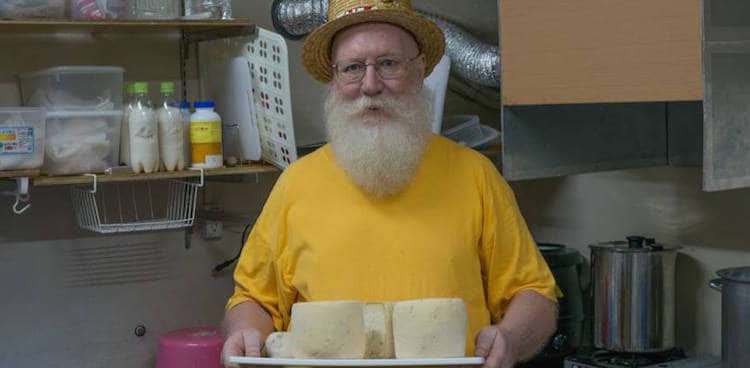
Let’s pretend that you are a world-traveling, cheese-loving teacher from England who finds yourself in Japan in the late ’70s. While enjoying all that Japan has to offer, you decide to make cheese toast because you are just a little homesick. You know that this simple delight will bring back memories of your childhood and will help your transition to your new home. While at your local grocery you stroll over to the cheese counter (or what you assume to be the cheese counter) and, to your horror, you only see neon, heavily processed blocks of goo that the kind gentleman behind the counter assures you is cheese.
This was the sad state of affairs for John Davis. When Mr. Davis moved to Tokyo in 1976 to open a language school, he was dismayed by the limited and processed cheese options that were available to him. After many years in Japan teaching, he and his wife settled in Okinawa in 2005 for what they thought would be a peaceful retirement. Little did they know they would create some amazingly innovative Japanese cheese and witness the birth of the Cheese Guy in Okinawa.
At first, Davis brought back as much cheese as he could from his travels, but it would not satiate his cheese needs. One brief glimmer of hope in the cheese-desert of ’70s Japan was a gift of canned Camembert, but even that was not to be: after waiting two hours for the rock-solid brick to thaw, Davis discovered that in English, German, French, and Italian the label warned, “Do not freeze!”, while in Japanese it said, “Please keep in the freezer!” Importing cheese cultures was a no-go due to the import barriers, so in the end Davis just decided he was going to have to make his own cheese. Starting off using supermarket milk, Davis soon had a small cheese factory on his hands, and more orders were coming in than cheese was able to go out. What was at first just a wish to stock his own kitchen turned out to be a profitable enterprise.
Davis embraces his location and incorporates as many local ingredients as possible in his cheese. These days all the milk comes from his friend’s nearby Holstein herd for the best flavor. He insists on getting salt only from Aguni Island, where workers sun-dry the purest waters from the East China Sea. The salt contains as many as 60 different kinds of minerals such as selenium, phosphorous, and manganese which promote good health. Davis also flavors his cheese with local ingredients like tamogitake, or golden oyster mushrooms;

yomogi, or Japanese mugwort (which has a bitter taste);

and beni-imo, or Okinawan sweet potato,

not to mention day lily, long pepper, and hibiscus tea. Experimentation is Davis’s favorite method of invention, and he is currently working on cheese infused with Hokkaido ale.
Davis sells his cheeses through the local farmer’s market every Friday in the village of Ozato. His mission is to get Okinawa on the map as a food-destination and works with local restaurants and foodies to increase their knowledge and palette for cheese.
Today, Davis has hired three full-time cheesemakers and a secretary to help him meet the cheese demand. He always welcomes volunteers that are willing to wash and clean up (compensated with delicious nibbles of cheese, of course). He hopes to start a cheese cave on a nearby plot of land so he can expand his line.
Stephen Mansfield, “A Slice Less Ordinary: The ‘Cheese Guy’ of Okinawa,” Japan Times Photos by Stephen Mansfield and the Cheese Guy in Okinawa


